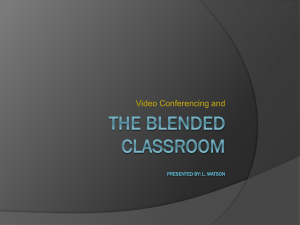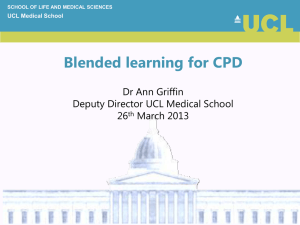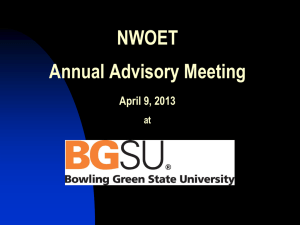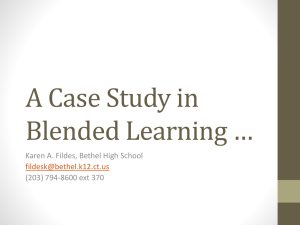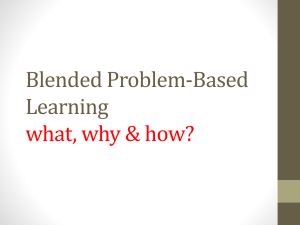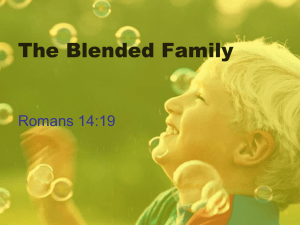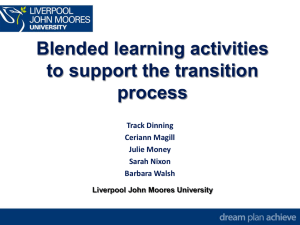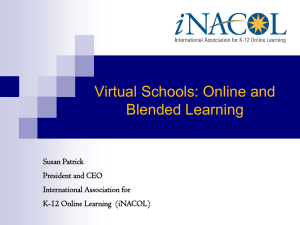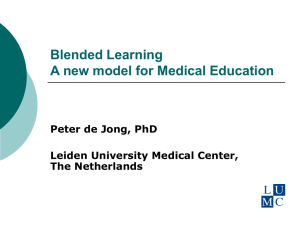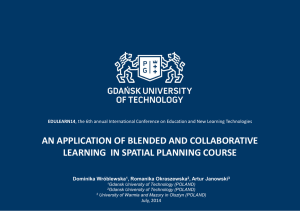Presentation
advertisement
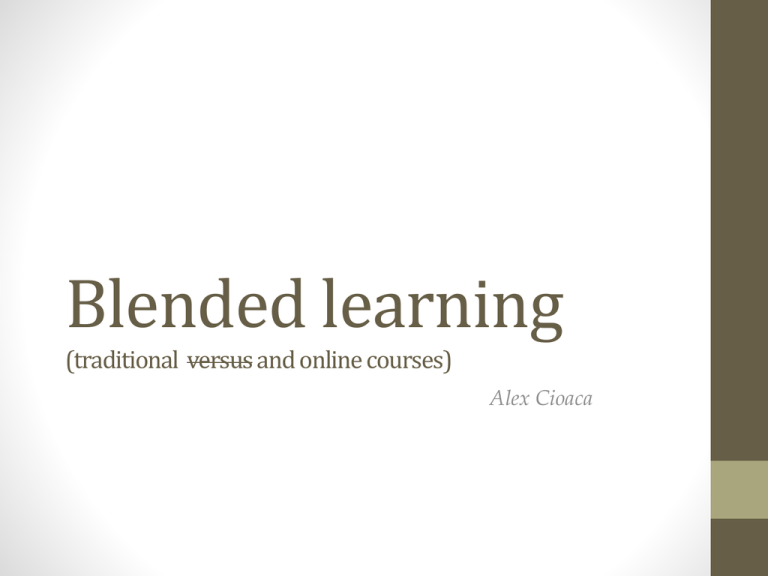
Blended learning (traditional versus and online courses) Alex Cioaca Talk Outline 1. 2. 3. 4. 5. Core ideas Research study Some theory Online tools Conclusions Paradigm shift in education Before • Deliver instruction After •Produce and sustain learning •Use technology for distance edu •Build sense of community “.. with the move from an agrarian to an industrial economy, the small rural schoolhouse was supplanted by the big brick schoolhouse. Four decades ago we began to move to another economy but we have yet to develop a new educational paradigm, let alone create the ‘schoolhouse’ of the future, which may be neither school nor house” - Davis and Botkin (1994) Producing learning Involves active group construction of knowledge, rather than transfer of knowledge. Schools • setting the basis for lifelong, independent learning • moving from a lecture-based paradigm to a model where learners are the focus Teachers • in charge with the design of learning environments • attending to the students’ intellectual growth, autonomy and social awareness Students • practicing their ability to become productive members of society • learning how to think, learn, produce, and evaluate knowledge Producing learning Challenges • employing new pedagogies and technologies • estimating the depth and speed of the changes required to stay competitive • inside pressure to preserve the status quo Distance education The shift from providing exclusively traditional classroom instruction to reaching out to students by delivering courses at distance using technology. Remarks • students and teachers react to new educational technologies with varied emotions, ranging from enthusiasm to disabling fear (Collins, 1999) • some experience difficulty adjusting to the structure of online courses and managing their time in such environments (Marino, 2000) • distance education requires students who are self-regulated and independent (Abrahamson, 1998) • electronic tools provide a level of reflective interaction that is often lacking in a face-to-face, teacher-centered classroom Distance education Challenges • bad course design and pedagogy for teachers with limited skills in CMC • the absence of facial expressions and voice inflections • confusion, anxiety, and frustration due to the perceived lack of prompt or clear feedback from the instructor through electronic media Sense of community The need for authentic community in schools, a tie binding learners and teachers through shared values, ideals, and goals. Represents a major cause of dropouts among students because of: • insufficient interaction with peers and faculty • differences with the value patterns of the group • general feeling of not fitting in or being isolated Blended Learning Definition The hybrid of traditional face-to-face and online learning so that instruction occurs both in the classroom and online • offers students and teachers both flexibility and convenience • makes efficient use of existing university infrastructure and the student resources • the face to-face component can be either on the main university campus or the professor can travel to a remote site in order to meet with students • the online component becomes a natural extension of traditional classroom learning • the design of a blended course can lie anywhere between opposite ends of fully faceto-face and fully online learning environments Research study Assumption In blended learning, students feel a greater sense of community (Also, what about the learning experience?) Reasoning A combination of face-to-face and online learning environments provides a greater range of opportunities for students to interact with each other and with their professor. These interactions should increase: • socialization • sense of being connected to each other • construction of knowledge through discourse Research study Location Small accredited university located in an urban area of southeastern Virginia Subjects 68 graduate students enrolled in three graduate-level education courses during the same semester. 100% 2 5 4 24 23 21 80% . 60% 40% 20% 0% Refused Volunteered • Also met on-campus • One 1-hour session per week (16 hours total) • Blackboard LSM for course material and conversations • Textbook study assignment • Practical applications • Collaborative action research • Group project Fully online • Met on-campus • One 3-hour session per week (48 hours total) • No online tech • Textbook study assignment • Lecture with classwide discussion • Collaborative and individual group work (2-3 students) Blended Traditional Course methodologies • Blackboard LSM • Group discussion boards, 12-15 students each • Individual work • Collaborative work as a weekly problem-oriented discussion topic Procedure and instrumentation • Connectedness and learning measured with the Classroom Community Scale (CCS) • 20 self-report items such as “feel isolated” / “feels like a family” • 5-point Likert scale (strongly agree, agree etc) • Connectedness subscale = the feelings of students regarding their cohesion, community spirit, trust, and interdependence • Learning subscale = the feelings of students regarding the degree to which they reached and shared educational goals • Scores on each subscale can range from 0 to 40 • There were no significant differences in the composition of the three courses by gender, age, or ethnicity Procedure and instrumentation • Traditional and blended course participants completed the CCS in-class • Pretest – 2nd week; Posttest – the final two weeks of the semester • Participants were unaware of their final grades when doing the CCS test • A causal-comparative design was used to determine whether the mean differences in sense of community at the end of each course were larger than expected by chance. • Since random assignment of participants to groups was not possible, the data was analyzed using a multivariate analysis of covariance (MANCOVA) to provide statistical matching of groups based on the pretest results • Effect size was calculated using the eta-squared statistic and interpretation was based on Cohen’s thresholds (.01 small / .06 moderate / .14 large) Results 40 32.63 34.18 26.7 30 30.57 32.57 26.57 20 10 4.12 2.39 4.10 2.76 3.83 4.61 PRETEST Connectedness Learning 0 Traditional 40 32.5 35.88 Blended Fully online 32.7 34.26 33 POSTTEST 29.29 30 20 4.85 3.55 4.42 3.74 8.45 6.20 10 Connectedness Learning 0 Traditional Blended Fully online Interaction in (distance) education Learner-Teacher Learner-Learner Learner-Content Learner-Interface Vicarious and passive Teacher-Content, Content-Content, Teacher-Teacher Interaction in (distance) education Teacher presence Definition The design, facilitation, and direction of cognitive and social processes for realizing learning outcomes that are meaningful and educational. Behavioral indicators • clearly communicating course objectives and instructions • facilitating student progress and learning • providing meaningful feedback Cognitive presence Definition The ability of participants to construct and confirm meaning through sustained reflection and discourse. Behavioral indicators • events triggering exploration of the subject • integrating new knowledge to construct meaning • resolutions enabling learners’ application of new knowledge to authentic contexts beyond the classroom Social presence Definition The ability to establish a sense of immediacy, connection, and co-presence between participants in spite of a distributed medium. Behavioral indicators • humor • self-disclosure • the use of informal language Online tools for blended learning • Top-level Universities are already offering blended learning courses that take advantage of new technology • For reasons of platform compatibility, web-based tools (SaaS) are gaining more popularity. Mobile apps available, too • Some tools are free to use, and some not • They need to bring clear improvements on the learning process • Must fulfill the teaching, cognitive or social presence Collaborative work environments • Social presence? Cognitive presence? • Allow students to collaborate on tasks and projects • Many possible types of resources: text, pictures, sound, diagrams etc • Traditional way = iterating over work, one person at a time • More advanced = CVS (github, mercurial) • Real-time collaborative work environments • Most popular example – Google Docs Collaborative work – Etherpad Collaborative work – Twiddla Brainstorming – Bubbl.us Brainstorming - Mindmeister Communication • Online campuses (better suited for fully-online courses) • Forums • Q & A sites • Piazza • Tutorhub • Quora • Notice boards • Wallwisher • Stixy • Integration with social networks • Inigral • GoingOn Notice boards – Wallwisher Notice boards – Linoit Course management tools • Quizzes • Google Docs + Flubaroo • Proprofs • Classmaker • Polls • Poll Everywhere • Gradebooks • LearnBoost • Miscellaneous Management – LearnBoost Management – Three Ring Personalized learning • Customized learning path • OpenEnglish • Knewton • Learning through games • Quizlet • Mindsnacks • Lumosity • Building online reputation • Openstudy • Top Hat Monocle Augmented Reality AR is a live, direct or indirect, view of the real-world environment whose elements are augmented by computer-generated sensory input such as sound, video, graphics or GPS data. AR became popular over the last years because of smartphones. MIT course designed by “The Education Arcade” where students are sent on the field to investigate a toxic spill. Clues about the subject are virtual and generated by a central computer, which makes the game different each time. Students use mobile devices Augmented Reality – Leafsnap For botanical sciences, forestry etc Identifies plant by leaf shape Augmented Reality – Audobon For zoology, wildlife sciences etc Identifies birds from the sound they make Wikis • Easy to “use” (aka read) and edit • Free of charge • Types of knowledge • theory, facts, data, photos etc • relations and categories • refinement processes • Roles in education • Learning source • Test-bench or class project • Assessment (Wikipedia game) Virtual classroom • Has to provide an environment resembling to the classroom • Ability to broadcast • • • • Audio Video Text Other resources • Software-based tools are more popular for now • Web-based are starting to gain some popularity (HTML5?) VC – Big Blue Button Learning management systems • Integrates most of the tools presented so far • Should communicate (import / export) with standalone tools • Design question: do we need all these features? • Examples: Moodle, Blackboard, Mindtap, Coursekit LMS – Coursekit LMS – Instructure eTextbooks Readers • Kno • ElevenLearning eTextbook readers usually contain features such as highlighting, annotation, thesaurus, exporting etc Content creators, editors and distributors • Cengage • Wiley • McGraw-Hill eTextbooks – Kno eTextbooks – Kno eTextbooks – CourseSmart eTextbooks – Inkling eTextbooks – Inkling Conclusions • Blended learning is a (proven) better alternative than traditional or fully online courses • With recent advances in technology, there is a rich offering of tools that can help instructors and students in blended learning • However, these tools fall under only 6-7 categories. There is still room on the market for even more products • No such thing as a critical mass of tools or a single swissknife. Choosing a set of tools has to take into account the education level and the curricula • Tools that are not created specifically for education can still be used in blended learning, by changing the perspective on how to use them • eTextbooks trends similar to Web 2.0: working and logging in the cloud, integration with social networks, heavy use of multimedia References “Blended Learning and Sense of Community: A comparative analysis with traditional and fully online graduate courses” – Rovai, Jordan “Virtual interaction: Design factors affecting student satisfaction and perceived learning in asynchronous online courses” - Swan American Journal of Distance Education Journal of Computer-Assisted Education Canadian Journal of Distance Education • http://www.classroom-aid.com • http://c4lpt.co.uk (Center for Learning and Performing Training) The end


